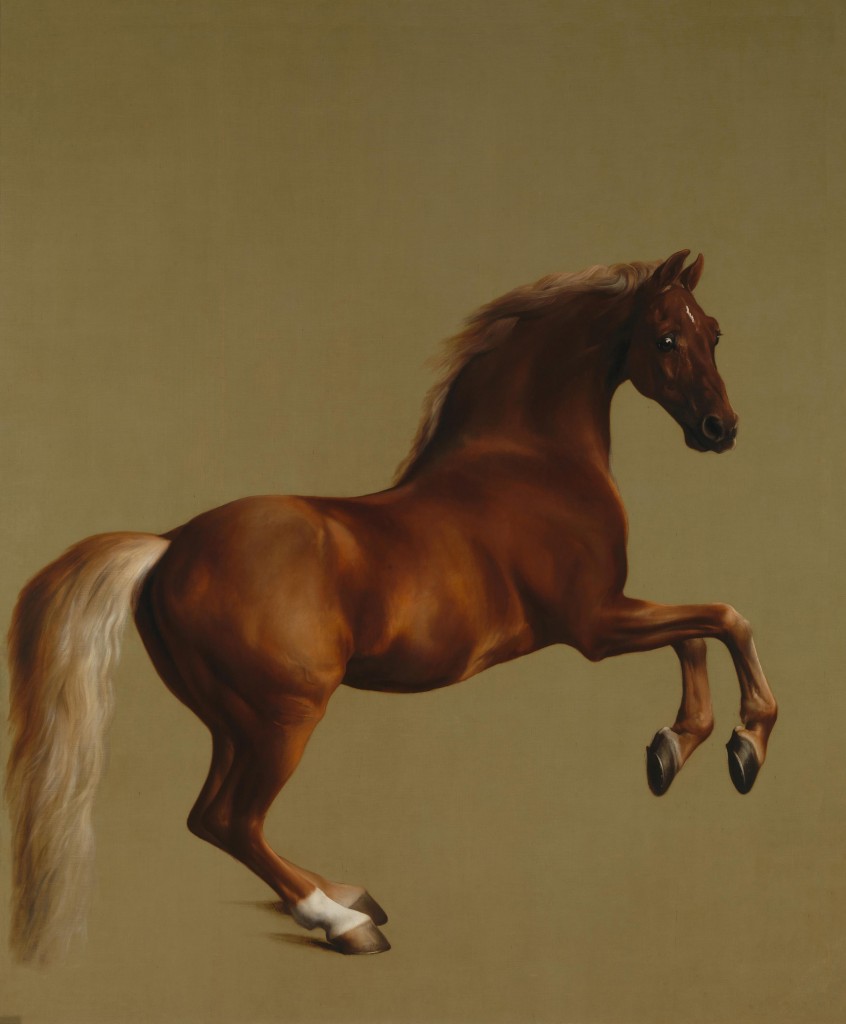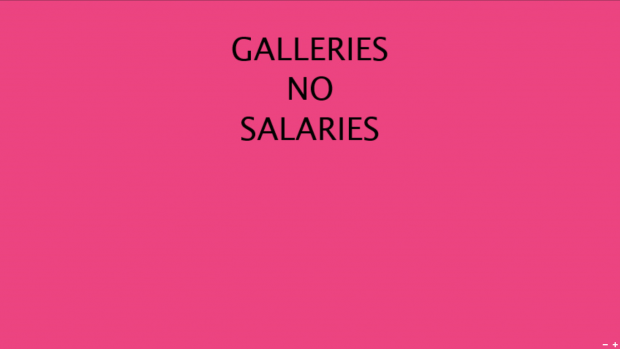EMILY GRUZDOWICH analyses George Stubbs’ Whistlejacket and makes a case for equine painting for ‘GALLERIES- NO SALARY’.
Pulsating, blood courses through the creature’s veins. Rearing, weight shifts onto the haunches, catalyzing a tremendous upward motion. Whinnying, nostrils flare, ejecting moist heated air. Craning, the head turns to face outwards, confronting, or even challenging, the spectator. Shifting, the mane and tail whistle—a reaction to a passing breeze or simply to the sudden movement of the horse.
However, the momentum generated from this acrobatic vault is halted. George Stubbs captures Whistlejacket mid-rear, crafting a quasi-photographic image of the horse. Here Whistlejacket is performing a ‘levade’; this dressage terminology refers to a halted movement between standing and rearing. However, the painter rather than a rider has halted Whistlejacket’s trajectory. His unbridled movement, unencumbered by a rider is entirely natural. The solid beige background functions as a photographic tarp. Devoid of landscape, the austere background primes the viewing experience. Unlike many equestrian portraits, Stubbs’ work glorifies horses in isolation rather than depicting them in relation to their riders. The spectator, unsure of whether the horse is performing a natural manoeuvre or responding to a command, is simply left to admire the taught musculature of the 2nd Marquess of Rockingham’s exquisite Arabian stallion.
Stubbs’ monumental oil on canvas painting of the racehorse (292 x 246.4 cm) holds court in Room 34 of London’s National Gallery. Light refracts against the horse’s luxurious chestnut coat, infusing the picture with a sense of kinetic energy. Segments of Whistlejacket’s coat are of a lighter hue, an effect of light and of natural dappling. The tale and mane are suspended; their airiness reinforce the sold, chiseled mass of the animal’s frame. Flecks of white denote the horse’s unbridled energy and mental capacity. Such white accents—the jagged blaze, right stocking, and hair—further unite the canvas. The physical and geometric perfection of Whistlejacket, which spurred the Marquess to commission Stubbs’ painting, are recorded with Stubbs typical anatomical accuracy.

A sporting artist only posthumously recognised by The Royal Academy, Stubbs has a lyrical manner of painting, which allows him to convey both the raw physicality and innate astuteness of horses. Rather than asserting his mastery over them, Stubbs celebrates the strong, yet supple power of his subject. Stubbs is known for revolutionising equine painting, and studied equine anatomy much like Da Vinci studied human anatomy. In 1756 Stubbs spent 18 months in Lincolnshire dissecting horses. Determined to acquire a practical knowledge of equine physiology, Stubbs suspended cadavers and manoeuvred them into different positions to better understand the orthopaedic and muscular make up of the animals. Equine painting was a lucrative profession, and as a result of his practical anatomical research Stubbs became the primary equine painter of his day.
The subject, as well as the artist, was one of the foremost in its contemporary field. Beaten only four times in his racing career, Whistlejacket became synonymous with speed and flight. Immortalised in literature as well as on Stubbs’ canvas Whistlejacket is mentioned in Oliver Goldsmith’s comic play She Stoops to Conquer (1773). When an elopement is planned the escape is discussed in relation to Stubbs’ subject: ‘I have got you a pair of horses that will fly like Whistlejacket’.
Whistlejacket is one of the National Gallery’s most significant recent acquisitions. It was purchased from the Earl of Rockingham’s heirs for 11 million in 1997. Frequently featured on National Gallery pamphlets, postcards, and posters, this widely disseminated image is acknowledged, but rarely scrutinised by young spectators. Given the wealth of accessible art in London it is easy to pass over equestrian portraiture. Yet Stubbs’ painstaking and anatomical approach to realism (almost photorealism) ensure that equine painting is a genre through which more modern work can be contextualised.
‘Whistlejacket’ by George Stubbs can be found in room 34 of the National Gallery. Admission is free.





